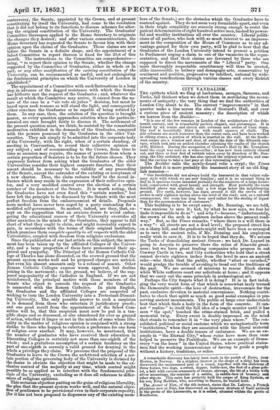CITY VANDA LIAM.
Tux epithets which we fling at barbarians, savages, Saracens, and Turks, fall thickest when we detect them in mutilating the monu- ments of antiquity; the very thing that we find the authorities of London City about to do. The current " improvements " in that make lre a. line across the site of Gerrard's Hall, and over a curious piece of ancient masonry; the description of which we borrow from the Builder— "It is one of the few remains in London of the architecture of the thir- teenth century, and is remarkably perfect, elegant, and picturesque. It is formed by six centre and eleven side columns and arches of Caen stone. i The roof is beautifully filled in with small squares of chalk. The side columns are much narrower than the centre ones, and have been worked in oblong stones, a portion of which is inserted in the wall. At the South- west corner are a window and door, of about the date of the fifteenth cen- tury, which look into an arched chamber adjoinini the vaults of the church of St. Mildred. During the occupation of Gerrard s Hall by Mr. Younghus- band the crypt was used as a wine-cellar; it has now been entirely cleared out, and three or four feet of rubbish taken away by direction of Mr. Bun- ning, the City architect, who has also opened the original windows, and ena- bled the curious to take a last peep at this interesting relic." The Builder calls the newly-found relic a crypt; the Times insists that it is more probably the basement story of an old Eng lish mansion- " Our forefathers did not always build the basement in that vulgar ours- nary style with which we are now familiar ; and it is no unusual thing to find in it spacious rooms intended probably for the retainers of a large house- hold, constructed with great beauty and strength. Most probably the room described above was originally only a few steps below the neighbouring ground. The earth, however, has risen around it till the crown of the arches is only eighteen inches above the level of the road; and, as a natural consequence, the room has long been used rather for the storing of liquor than for the accommodation of customers."
This building is to be swept away. Mr. Bunning, we are told, " was anxious to save it; but, by what he now says, we fear he finds it impossible to do so " : and why ?—because, " unfortunately, the crown of the arch is eighteen inches above the present road- way." But, as the Times remarks, " where there is a will there is a way ": all streets are not a dead level; the proposed street lies on a sharp hill, and the gradients might well have been so arranged as to save the ancient relic, if Mr. Bunning and his employers really wish to save it. It is to be hoped that they do. We accuse the Turks of demolishing ancient ,Greece ; we back Dr. Layard in going to Assyria to preserve there the relics of Ninevite great- ness; but we have great trading companies who propose to cut Conway Castle in two, and City authorities who hold that a street cannot deviate eighteen inches from the level to save an ancient relic—who think that the public, whether "afoot or caroched," would grudge the trouble of avoiding to tread out the traditions of the past. We are accused of missions to rescue Black slaves while White sufferers court our solicitude at home ; and it appears that we carry out the same principle in archaeological art. Perhaps the City forgets what it is doing P It is in fact indul- ging the very worst form of that which is somewhat laxly termed the Democratic spirit—the love of destruction, irreverence for the past, exclusive devotion to material convenience. Nothing contri- butes to check that spirit so much as good social examples in pre- serving ancient monuments. The public at large ever understands best that which finds a body in the form of the concrete. It can- not " realize" to itself the full idea of a tragic murder until it has seen " the spot," touched the crime-stained brink, and pulled a memorial twig. Every event is doubly impressed on the mind that stands to remember it in " the very place where." The con- solidated political or social customs which we metaphorically term "institutions," when they are associated with the literal material institutions, have a double tenure of endurance. We see an ex- ample in " the Eternal City," whose ruins have more than once helped to preserve the Pontificate. We see an example of Demo- cracy "on the loose " in the United States, where practical states- men find the working inconvenience of having to guide a people without a history, traditions, or relics.


























 Previous page
Previous page